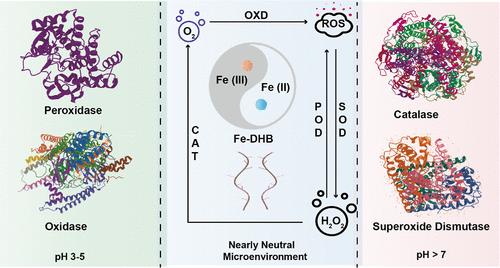一种促进伤口愈合的自循环微环境适应性纳米酶
IF 8.2
2区 材料科学
Q1 MATERIALS SCIENCE, MULTIDISCIPLINARY
引用次数: 0
摘要
纳米酶介导的活性氧(ROS)体内稳态调节是加速病原体感染伤口愈合的一种有前途的策略。在纳米酶制备过程中,平衡活性氧的产生和清除,适应伤口微环境,特别是克服酶活性中心丧失所导致的不可逆和不可避免的失活是非常不利的。本文通过调整配体和金属电荷转移,制备了具有再生Fe(II)活性中心的纳米酶,在相同的中性pH环境下,实现了过氧化物酶、超氧化物歧化酶、过氧化氢酶和氧化酶的循环连续氧化还原酶反应。这种多用途的酶活性可以很容易地被氧/ROS触发,并级联到可控和可逆的ROS生成和清除,以及在感染伤口恢复过程中加速杀菌的氧气释放。在超低剂量Fe-DHB下,对1 × 106个耐药菌有显著疗效,创面愈合速度约为6.3 mm2 / d。我们的工作在基于纳米酶的伤口愈合策略设计方面取得了重大突破。本文章由计算机程序翻译,如有差异,请以英文原文为准。

A Self-Circulated Microenvironment-Adaptive Nanozyme for Wound Healing Acceleration
Nanozyme-mediated reactive oxygen species (ROS) homeostasis regulation in vivo is a promising strategy for accelerating the healing of pathogen-infected wounds. It is detrimental in nanozyme preparation to strike a balance between ROS production and scavenging, being adaptive to the wound microenvironment, especially to overcome the irreversible and inevitable inactivation caused by the enzymatic active center loss. Herein, with adjusting ligands and metal charge transfer, we prepared a nanozyme with a regenerated Fe(II) active center, which endowed cyclic and continuous oxidoreductase reactions of peroxidase, superoxide dismutase, catalase, and oxidase under the same neutral pH environment. The versatile enzymatic activity could be easily triggered with oxygen/ROS and cascaded into controllable and reversible ROS generation and scavenging, as well as oxygen release for acceleration of sterilization during infected wound recovery. Under ultralow dosage of Fe-DHB, remarkable effectiveness against 1.0 × 106 drug-resistant bacteria and a wound-healing rate of around 6.3 mm2 per day were realized. Our work presents a key breakthrough in nanozyme-based wound healing strategy design.
求助全文
通过发布文献求助,成功后即可免费获取论文全文。
去求助
来源期刊

ACS Applied Materials & Interfaces
工程技术-材料科学:综合
CiteScore
16.00
自引率
6.30%
发文量
4978
审稿时长
1.8 months
期刊介绍:
ACS Applied Materials & Interfaces is a leading interdisciplinary journal that brings together chemists, engineers, physicists, and biologists to explore the development and utilization of newly-discovered materials and interfacial processes for specific applications. Our journal has experienced remarkable growth since its establishment in 2009, both in terms of the number of articles published and the impact of the research showcased. We are proud to foster a truly global community, with the majority of published articles originating from outside the United States, reflecting the rapid growth of applied research worldwide.
 求助内容:
求助内容: 应助结果提醒方式:
应助结果提醒方式:


